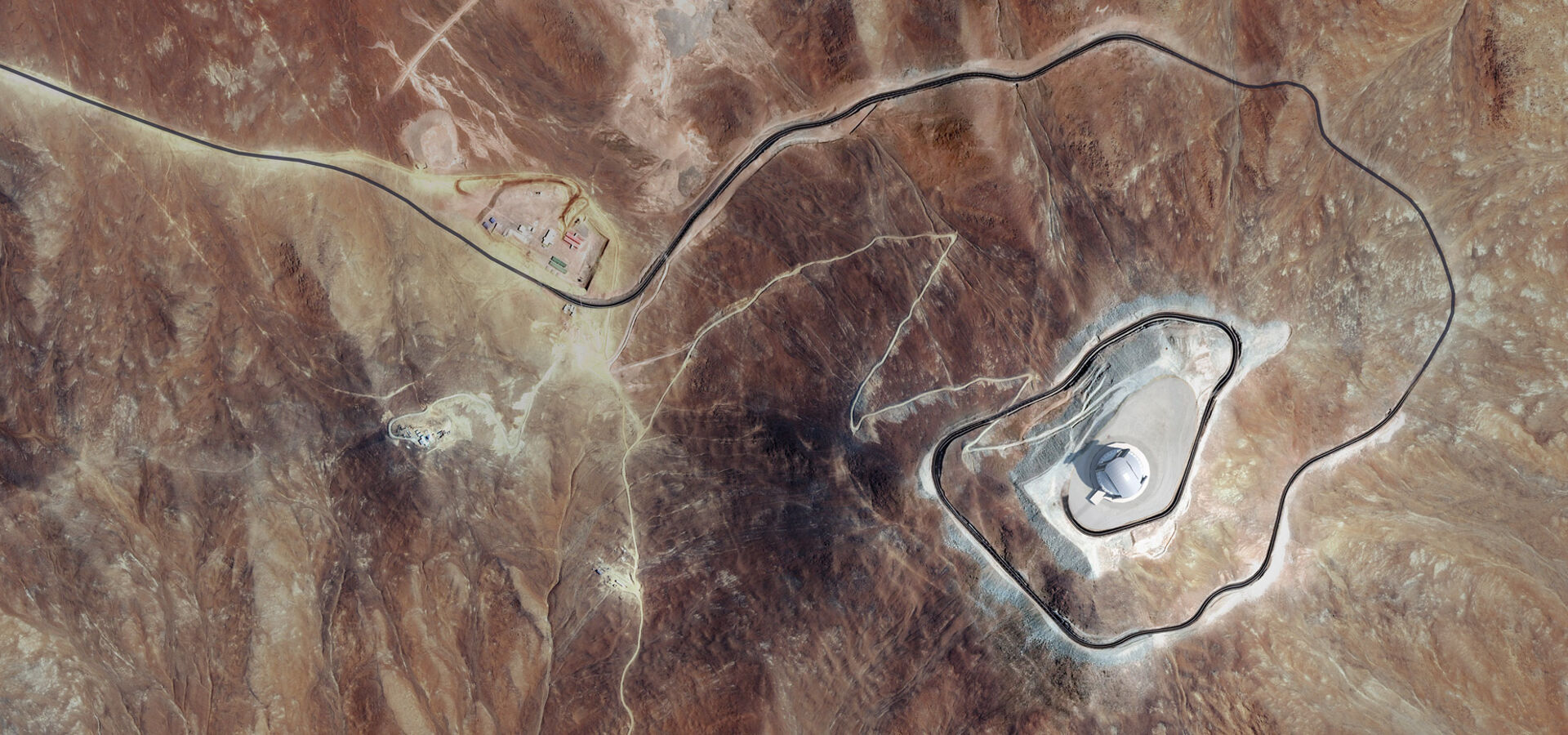
European
Southern
Observatory

An extraordinary telescope calls for an exceptional site. Great care was therefore taken to ensure that the home of the ELT was the best possible. This required a high, dry site — perfect for observations.
On 26 April 2010, the ESO Council selected Cerro Armazones as the site for the planned 40-metre-class ELT. Cerro Armazones is a mountain at an altitude of 3046 metres in the central part of Chile's Atacama Desert, some 130 kilometres south of the town of Antofagasta and about 20 kilometres from Cerro Paranal, home of ESO's Very Large Telescope (VLT).
On 13 October 2011, an agreement was signed between ESO and the Chilean government, including the donation of 189 km2 of land around Cerro Armazones for the installation of the ELT, as well as a concession for 50 years relating to the surrounding area.
On 27 October 2013, the Chilean President handed over the signed legal documents by which the Chilean government transferred this land around Cerro Armazones to ESO.
To visit the ELT site, please check the travel information on the ESO website.
Cerro Armazones’ location in the dry Chilean desert at high altitude makes it ideal for astronomical observations. The altitude of the site above sea level does not pose logistical problems for operations, while meeting the science requirements for low precipitable water vapour and low operating temperatures. The median seeing is 0.67 arcsec at 500 nm with a median coherence time of 3.5 ms. The rainfall in one year is of the order of 100 mm, with a median relative humidity value of 15%. The wind rose for Armazones is strongly focused to the north with almost no wind coming from the east, with a median mean wind speed of 7 m/s. The air temperature ranges between -15°C and +25°C, with a yearly median nighttime air temperature of 9°C with +/- 1.5°C median seasonal variations. The average air temperature difference between day and night is 4°C, and the typical air temperature gradient at night time is 0.3°C/h over 10 hours.
The decision on the ELT site was based on an extensive comparative meteorological investigation, which lasted several years.
The site selection process took several factors into account. The “astronomical quality” of the atmosphere, that is, the number of clear nights, infrared properties (height, temperature, precipitable water vapour, etc), seeing, atmospheric turbulence profile, mean coherence length and time, outer scale length, among other factors, played a crucial role. The selection also considered the operation and scientific synergy with other major facilities, such as with the VLT and other telescopes at ESO’s Paranal Observatory and with ALMA, the Atacama Large Millimeter/submillimeter Array. A significant role was played also by construction and logistical aspects, such as: the impact of the location on construction cost and schedule, considerations on where the observatory staff will live, if power grids capable of providing 10MW of power for observations were conveniently close, supply of water and so on.
A Site Selection Advisory Committee was formed to advise the ESO Director General and the ESO Council on the site choice. This independent committee investigated several possible sites worldwide in great detail. The team also took into account the studies on sites done by the Thirty-Meter Telescope site selection team from the US, which were all in North and South America.
In March 2010, the ESO Council received a preliminary report with the main conclusions from the ELT Site Selection Advisory Committee. These conclusions confirmed that all the sites examined in the final shortlist (Armazones, Ventarrones, Tolonchar and Vizcachas in Chile, and Roque de Los Muchachos (La Palma) in Spain) have very good conditions for astronomical observing, each one with its particular strengths. The technical report concluded that Cerro Armazones stood out as the clearly preferred site because it has the best balance of sky quality for all the factors considered and can be integrated with ESO’s Paranal Observatory, located just 20 km away. Cerro Armazones and Paranal share the same ideal conditions for astronomical observations, including over 320 clear nights per year. In addition, they are very remote sites in the Atacama Desert, offering some of the darkest skies on Earth with virtually no light pollution from human civilisation.
The site selection process was supported by FP6 activities described in an SPIE paper.
We use cookies that are essential for accessing our websites and using our services. We also use cookies to analyse, measure and improve our websites’ performance, to enable content sharing via social media and to display media content hosted on third-party platforms.
The European Organisation for Astronomical Research in the Southern Hemisphere (ESO) is the pre-eminent intergovernmental science and technology organisation in astronomy. It carries out an ambitious programme focused on the design, construction and operation of powerful ground-based observing facilities for astronomy.
This Cookies Policy is intended to provide clarity by outlining the cookies used on the ESO public websites, their functions, the options you have for controlling them, and the ways you can contact us for additional details.
Cookies are small pieces of data stored on your device by websites you visit. They serve various purposes, such as remembering login credentials and preferences and enhance your browsing experience.
Essential cookies (always active): These cookies are strictly necessary for the proper functioning of our website. Without these cookies, the website cannot operate correctly, and certain services, such as logging in or accessing secure areas, may not be available; because they are essential for the website’s operation, they cannot be disabled.
Functional Cookies: These cookies enhance your browsing experience by enabling additional features and personalization, such as remembering your preferences and settings. While not strictly necessary for the website to function, they improve usability and convenience; these cookies are only placed if you provide your consent.
Analytics cookies: These cookies collect information about how visitors interact with our website, such as which pages are visited most often and how users navigate the site. This data helps us improve website performance, optimize content, and enhance the user experience; these cookies are only placed if you provide your consent. We use the following analytics cookies.
Matomo Cookies:
This website uses Matomo (formerly Piwik), an open source software which enables the statistical analysis of website visits. Matomo uses cookies (text files) which are saved on your computer and which allow us to analyze how you use our website. The website user information generated by the cookies will only be saved on the servers of our IT Department. We use this information to analyze www.eso.org visits and to prepare reports on website activities. These data will not be disclosed to third parties.
On behalf of ESO, Matomo will use this information for the purpose of evaluating your use of the website, compiling reports on website activity and providing other services relating to website activity and internet usage.
Matomo cookies settings:
Additional Third-party cookies on ESO websites: some of our pages display content from external providers, e.g. YouTube.
Such third-party services are outside of ESO control and may, at any time, change their terms of service, use of cookies, etc.
YouTube: Some videos on the ESO website are embedded from ESO’s official YouTube channel. We have enabled YouTube’s privacy-enhanced mode, meaning that no cookies are set unless the user actively clicks on the video to play it. Additionally, in this mode, YouTube does not store any personally identifiable cookie data for embedded video playbacks. For more details, please refer to YouTube’s embedding videos information page.
Cookies can also be classified based on the following elements.
Regarding the domain, there are:
As for their duration, cookies can be:
Cookie settings: You can modify your cookie choices for the ESO webpages at any time by clicking on the link Cookie settings at the bottom of any page.
In your browser: If you wish to delete cookies or instruct your browser to delete or block cookies by default, please visit the help pages of your browser:
Please be aware that if you delete or decline cookies, certain functionalities of our website may be not be available and your browsing experience may be affected.
You can set most browsers to prevent any cookies being placed on your device, but you may then have to manually adjust some preferences every time you visit a site/page. And some services and functionalities may not work properly at all (e.g. profile logging-in, shop check out).
The ESO Cookies Policy may be subject to future updates, which will be made available on this page.
For any queries related to cookies, please contact: pdprATesoDOTorg.
As ESO public webpages are managed by our Department of Communication, your questions will be dealt with the support of the said Department.